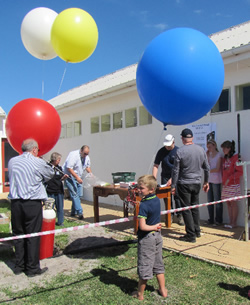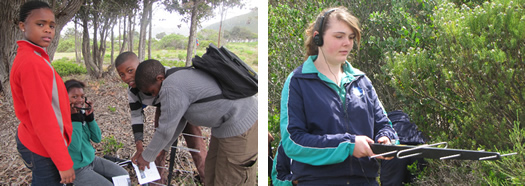| 46% of getS.E.T.go! readers think that the most important benefit of South Africa’s recent participation in the Shanghai Expo, will be the raising of our country’s science & technology profile on the global stage. | |
| 38% opted for “sharing of international best practices in maths & science education”; and 15% for “building an international network of contacts”. |
Almost 21 000 learners from around South Africa and SADC countries participated in the Science Olympiad this year.

It has become tradition for the Hermanus Magnetic Observatory (HMO) to commemorate World Space Week each year, and 2010 was no exception. Young science enthusiasts were in their element, playing GPS-based track-and-find games, building model satellites and getting a healthy helping of the world of space science.
Since 1999 the week of 4 to 10 October has been recognised by the United Nations General Assembly as an international celebration of science – one that encourages, educates and commemorates space exploration across the world.
This year’s theme was “Mysteries of the Cosmos", which the HMO embraced by filling the week with info and activities relating to satellites, how they get into space, their orbits and the conditions in which they function.
The programme included learner activities on satellites orbiting the Earth and space weather; a public lecture on space weather; and an open day at the facility with track-and-find games, radar navigation, water rockets, and the launch of a balloon with a GPS instrument on board.
Learners were able to view conditions in space and observe the Sun through different filters in real time at the HMO Space Weather Centre. Space officers Kobus Olckers and Mpho Tshisaphungo also gave explanations and answers to many excited questions from the enthusiastic youngsters.
“Since our mission was to educate learners about satellites, we thought what better way to get the message across than to talk to the people who actually build them,” says Msizi Kathide of HMO’s science awareness programme. “We are fortunate in that some of our scientists lecture to students at the Cape Peninsula University of Technology in the F’SATI programme, which is a joint venture with France in which masters engineering students design and build so-called CUBESATS.”
These students joined the learners for a day, explaining the details of building one of these 10cm x 10cm x 10cm satellites, and the costs involved in deploying them.
The highlight was without doubt the open day on the Saturday, where learners were introduced to the game of “foxhunting”, in which transmitters are hidden around a certain area for teams armed with receivers to try and locate. The transmitters emit a beep sound that is picked up by the receiver and which gets stronger as you get closer to it. The first team to locate all transmitters wins.
The water rocket activity proved as popular as ever, but the Lalela Balloon Launch was by far the most fascinating. This balloon is launched with a GPS on board, which constantly transmits back its location as it floats through the air, allowing learners on the ground to view a map of where and how far the balloon travels.
 |
Launching giant balloons, each with a GPS on board, from the Hermanus Magnetic Observatory. |
 |
| Hunting the “fox” – a track-and-find game enjoyed by youngsters at the Observatory. |
